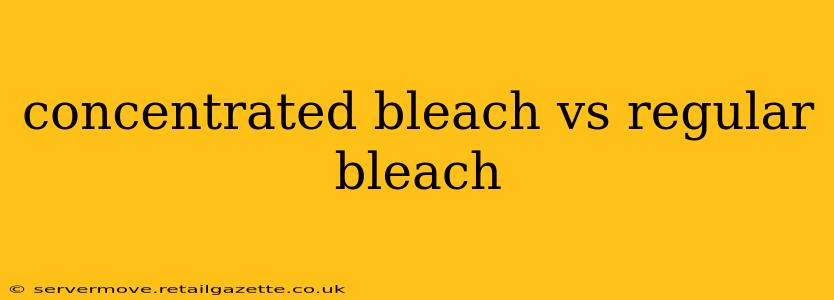Bleach is a common household cleaning product used to disinfect and whiten surfaces. But not all bleaches are created equal. Understanding the difference between concentrated bleach and regular bleach is crucial for safe and effective cleaning. This guide will clarify the distinctions, address common concerns, and help you choose the right bleach for your needs.
What is Concentrated Bleach?
Concentrated bleach, also known as high-concentration bleach or industrial bleach, contains a higher percentage of sodium hypochlorite (NaOCl) than regular household bleach. While regular bleach typically contains around 5-6% sodium hypochlorite, concentrated bleach can range from 8% to even 15% or more. This higher concentration means it's more potent and requires careful handling.
What is Regular Bleach?
Regular bleach, the kind readily available in grocery stores, is a diluted solution of sodium hypochlorite. Its lower concentration makes it safer for general household use, though it still needs to be handled with caution. The lower concentration also means it's less likely to damage fabrics or surfaces if used incorrectly.
How Concentrated is Concentrated Bleach? A Percentage Breakdown
The concentration of bleach is expressed as a percentage of sodium hypochlorite. The higher the percentage, the more potent the bleach. You won't find an exact percentage listed on all concentrated bleach products; however, be aware that a significantly stronger smell and more powerful cleaning action compared to regular bleach indicates a higher concentration. Always check the product label for specific instructions and safety precautions.
Is Concentrated Bleach More Effective?
While concentrated bleach is indeed more potent, this doesn't automatically translate to "better" for all cleaning tasks. Its increased strength means it can disinfect and whiten more effectively at lower dilutions, potentially saving you money in the long run. However, this increased potency also increases the risk of damage to surfaces or fabrics if not used correctly. Regular bleach is perfectly adequate for most household cleaning and disinfecting tasks.
What are the Safety Concerns with Concentrated Bleach?
The higher concentration of sodium hypochlorite in concentrated bleach increases the risks associated with its use:
- Increased risk of burns: Contact with concentrated bleach can cause severe skin and eye burns.
- Stronger fumes: The fumes from concentrated bleach are more potent and can be irritating to the respiratory system.
- Increased reactivity: Concentrated bleach is more prone to reacting violently with other chemicals, particularly acids. Mixing bleach with ammonia, for instance, is extremely dangerous regardless of concentration, but even more so with concentrated bleach.
When Should You Use Concentrated Bleach?
Concentrated bleach is typically used in industrial or commercial settings where its potent disinfecting and whitening power is necessary. Examples include:
- Industrial cleaning: Cleaning and sanitizing large facilities.
- Water treatment: Disinfecting water supplies.
- Pulp and paper industry: Bleaching paper pulp.
When Should You Use Regular Bleach?
Regular bleach is suitable for most household cleaning and disinfecting tasks, including:
- Laundry: Whitening and disinfecting clothes.
- Bathroom cleaning: Disinfecting toilets, sinks, and showers.
- Kitchen cleaning: Disinfecting countertops and other surfaces.
How to Safely Handle Bleach (Both Concentrated and Regular)
Regardless of the concentration, always follow these safety precautions when using bleach:
- Wear protective gear: Gloves, eye protection, and a mask are recommended.
- Ventilate the area: Open windows and doors to ensure proper ventilation.
- Never mix bleach with other cleaning products: This can create dangerous gases.
- Store bleach properly: Keep bleach away from children and pets, in a cool, dry place.
- Follow dilution instructions carefully: Always dilute bleach according to the manufacturer's instructions.
- Dispose of bleach properly: Follow local regulations for disposing of bleach.
What are the environmental concerns associated with bleach?
Both concentrated and regular bleach contain sodium hypochlorite, a chemical that can be harmful to the environment if misused or improperly disposed of. It's crucial to use bleach sparingly and dispose of it responsibly to minimize environmental impact.
By understanding the differences between concentrated and regular bleach and following safe handling practices, you can effectively utilize this cleaning product while minimizing risks and protecting the environment. Remember to always refer to the manufacturer's instructions on the product label for specific usage and safety guidelines.
